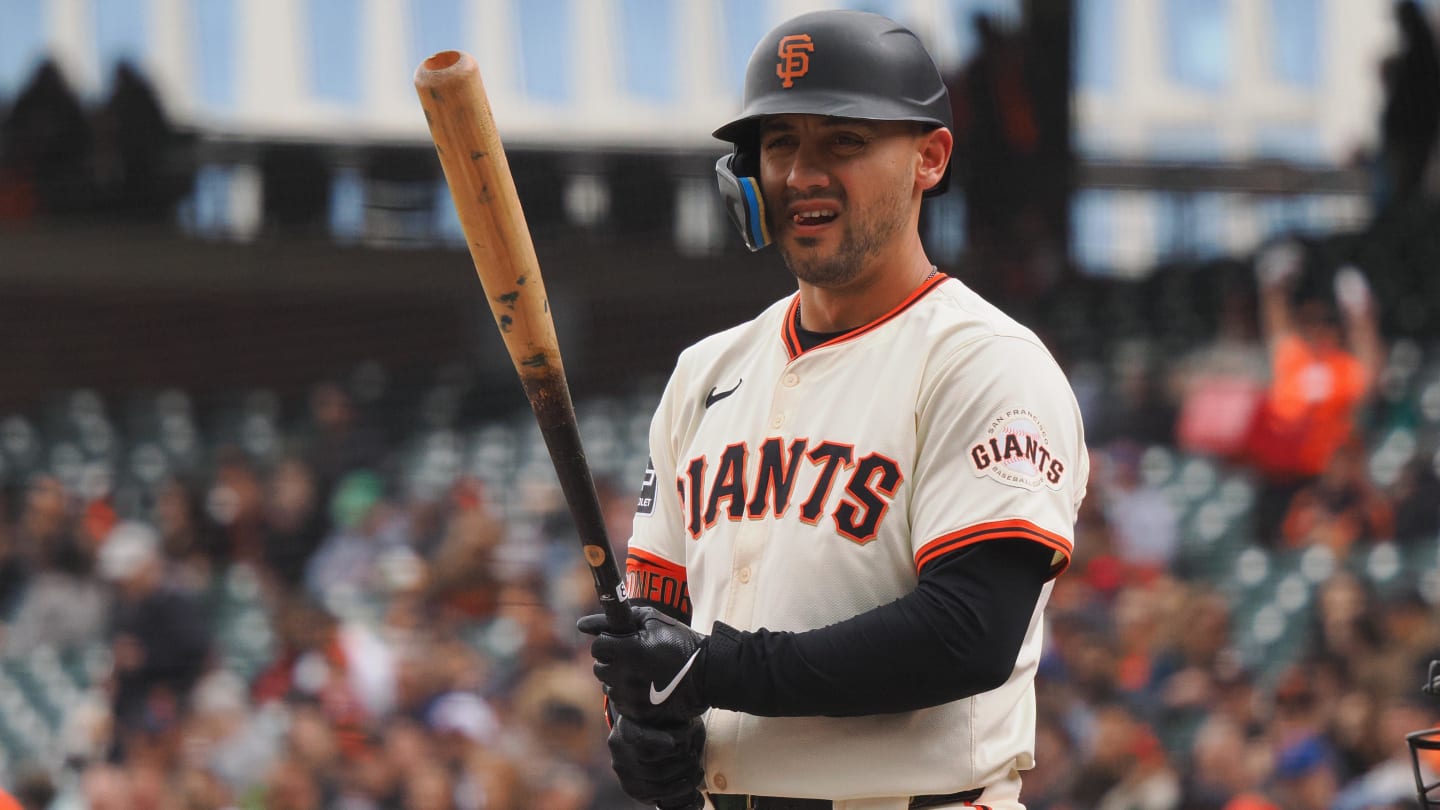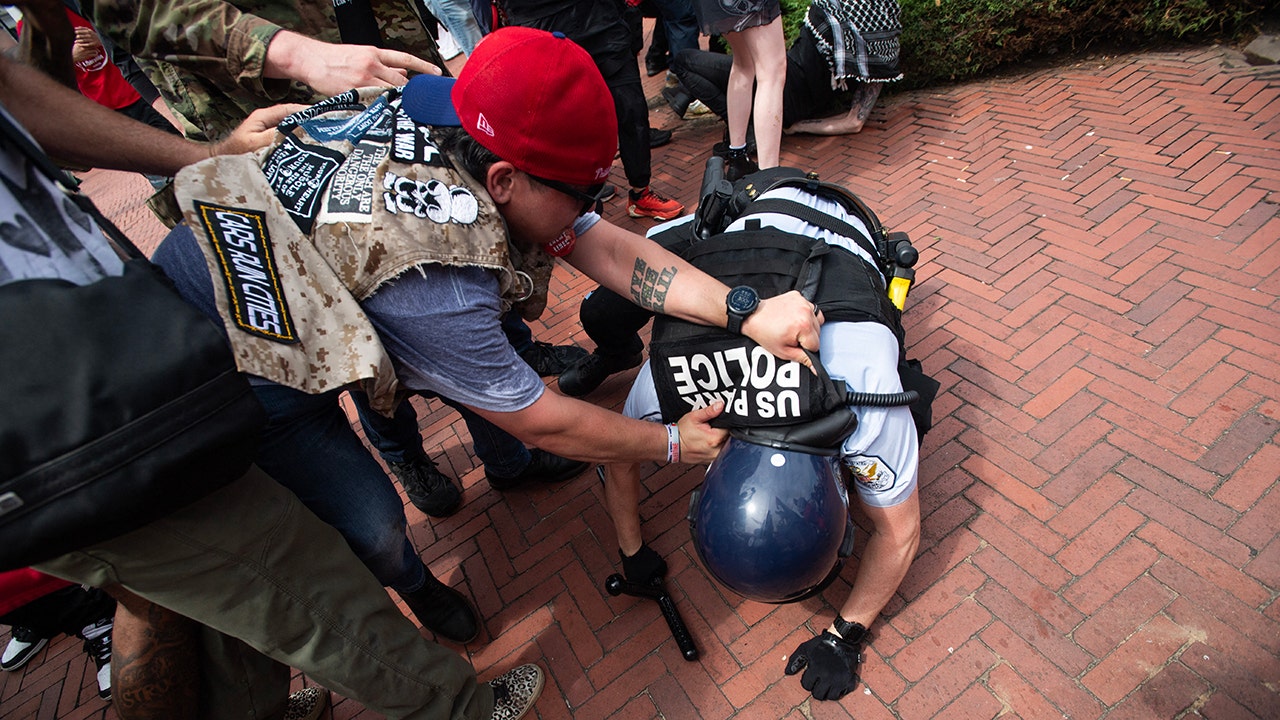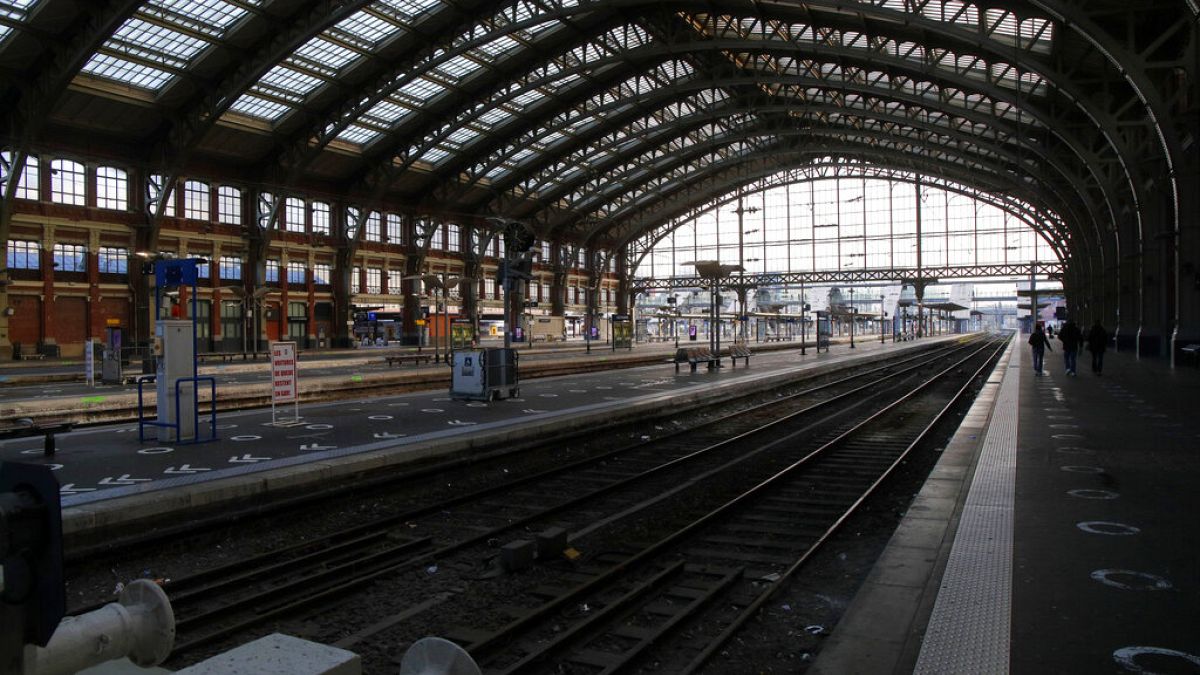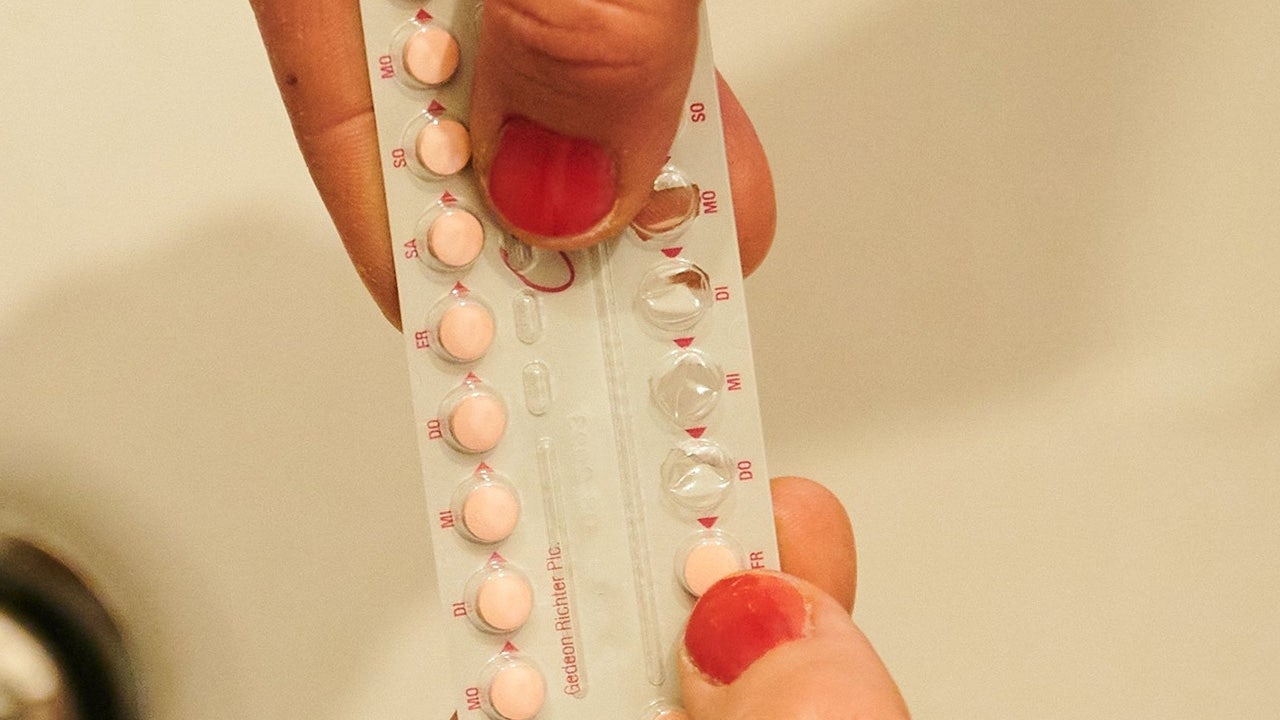Education
How Counterprotesters at U.C.L.A. Provoked Violence, Unchecked for Hours

A satellite image of the UCLA campus.
On Tuesday night, violence erupted at an encampment that pro-Palestinian protesters had set up on April 25.
The image is annotated to show the extent of the pro-Palestinian encampment, which takes up the width of the plaza between Powell Library and Royce Hall.
The clashes began after counterprotesters tried to dismantle the encampment’s barricade. Pro-Palestinian protesters rushed to rebuild it, and violence ensued.
Arrows denote pro-Israeli counterprotesters moving towards the barricade at the edge of the encampment. Arrows show pro-Palestinian counterprotesters moving up against the same barricade.
Police arrived hours later, but they did not intervene immediately.
An arrow denotes police arriving from the same direction as the counterprotesters and moving towards the barricade.
A New York Times examination of more than 100 videos from clashes at the University of California, Los Angeles, found that violence ebbed and flowed for nearly five hours, mostly with little or no police intervention. The violence had been instigated by dozens of people who are seen in videos counterprotesting the encampment.
The videos showed counterprotesters attacking students in the pro-Palestinian encampment for several hours, including beating them with sticks, using chemical sprays and launching fireworks as weapons. As of Friday, no arrests had been made in connection with the attack.
To build a timeline of the events that night, The Times analyzed two livestreams, along with social media videos captured by journalists and witnesses.
The melee began when a group of counterprotesters started tearing away metal barriers that had been in place to cordon off pro-Palestinian protesters. Hours earlier, U.C.L.A. officials had declared the encampment illegal.
Security personnel hired by the university are seen in yellow vests standing to the side throughout the incident. A university spokesperson declined to comment on the security staff’s response.
Mel Buer/The Real News Network
It is not clear how the counterprotest was organized or what allegiances people committing the violence had. The videos show many of the counterprotesters were wearing pro-Israel slogans on their clothing. Some counterprotesters blared music, including Israel’s national anthem, a Hebrew children’s song and “Harbu Darbu,” an Israeli song about the Israel Defense Forces’ campaign in Gaza.
As counterprotesters tossed away metal barricades, one of them was seen trying to strike a person near the encampment, and another threw a piece of wood into it — some of the first signs of violence.
Attacks on the encampment continued for nearly three hours before police arrived.
Counterprotesters shot fireworks toward the encampment at least six times, according to videos analyzed by The Times. One of them went off inside, causing protesters to scream. Another exploded at the edge of the encampment. One was thrown in the direction of a group of protesters who were carrying an injured person out of the encampment.
Mel Buer/The Real News Network
Some counterprotesters sprayed chemicals both into the encampment and directly at people’s faces.
Sean Beckner-Carmitchel via Reuters
At times, counterprotesters swarmed individuals — sometimes a group descended on a single person. They could be seen punching, kicking and attacking people with makeshift weapons, including sticks, traffic cones and wooden boards.
StringersHub via Associated Press, Sergio Olmos/Calmatters
In one video, protesters sheltering inside the encampment can be heard yelling, “Do not engage! Hold the line!”
In some instances, protesters in the encampment are seen fighting back, using chemical spray on counterprotesters trying to tear down barricades or swiping at them with sticks.
Except for a brief attempt to capture a loudspeaker used by counterprotesters, and water bottles being tossed out of the encampment, none of the videos analyzed by The Times show any clear instance of encampment protesters initiating confrontations with counterprotesters beyond defending the barricades.
Shortly before 1 a.m. — more than two hours after the violence erupted — a spokesperson with the mayor’s office posted a statement that said U.C.L.A officials had called the Los Angeles Police Department for help and they were responding “immediately.”
Officers from a separate law enforcement agency — the California Highway Patrol — began assembling nearby, at about 1:45 a.m. Riot police with the L.A.P.D. joined them a few minutes later. Counterprotesters applauded their arrival, chanting “U.S.A., U.S.A., U.S.A.!”
Just four minutes after the officers arrived, counterprotesters attacked a man standing dozens of feet from the officers.
Twenty minutes after police arrive, a video shows a counterprotester spraying a chemical toward the encampment during a scuffle over a metal barricade. Another counterprotester can be seen punching someone in the head near the encampment after swinging a plank at barricades.
Fifteen minutes later, while those in the encampment chanted “Free, free Palestine,” counterprotesters organized a rush toward the barricades. During the rush, a counterprotester pulls away a metal barricade from a woman, yelling “You stand no chance, old lady.”
Throughout the intermittent violence, officers were captured on video standing about 300 feet away from the area for roughly an hour, without stepping in.
It was not until 2:42 a.m. that officers began to move toward the encampment, after which counterprotesters dispersed and the night’s violence between the two camps mostly subsided.
The L.A.P.D. and the California Highway Patrol did not answer questions from The Times about their responses on Tuesday night, deferring to U.C.L.A.
While declining to answer specific questions, a university spokesperson provided a statement to The Times from Mary Osako, U.C.L.A.’s vice chancellor of strategic communications: “We are carefully examining our security processes from that night and are grateful to U.C. President Michael Drake for also calling for an investigation. We are grateful that the fire department and medical personnel were on the scene that night.”
L.A.P.D. officers were seen putting on protective gear and walking toward the barricade around 2:50 a.m. They stood in between the encampment and the counterprotest group, and the counterprotesters began dispersing.
While police continued to stand outside the encampment, a video filmed at 3:32 a.m. shows a man who was walking away from the scene being attacked by a counterprotester, then dragged and pummeled by others. An editor at the U.C.L.A. student newspaper, the Daily Bruin, told The Times the man was a journalist at the paper, and that they were walking with other student journalists who had been covering the violence. The editor said she had also been punched and sprayed in the eyes with a chemical.
On Wednesday, U.C.L.A.’s chancellor, Gene Block, issued a statement calling the actions by “instigators” who attacked the encampment unacceptable. A spokesperson for California Gov. Gavin Newsom criticized campus law enforcement’s delayed response and said it demands answers.
Los Angeles Jewish and Muslim organizations also condemned the attacks. Hussam Ayloush, the director of the Greater Los Angeles Area office of the Council on American-Islamic Relations, called on the California attorney general to investigate the lack of police response. The Jewish Federation Los Angeles blamed U.C.L.A. officials for creating an unsafe environment over months and said the officials had “been systemically slow to respond when law enforcement is desperately needed.”
Fifteen people were reportedly injured in the attack, according to a letter sent by the president of the University of California system to the board of regents.
The night after the attack began, law enforcement warned pro-Palestinian demonstrators to leave the encampment or be arrested. By early Thursday morning, police had dismantled the encampment and arrested more than 200 people from the encampment.

Education
The Youngest Pandemic Children Are Now in School, and Struggling

The pandemic’s babies, toddlers and preschoolers are now school-age, and the impact on them is becoming increasingly clear: Many are showing signs of being academically and developmentally behind.
Interviews with more than two dozen teachers, pediatricians and early childhood experts depicted a generation less likely to have age-appropriate skills — to be able to hold a pencil, communicate their needs, identify shapes and letters, manage their emotions or solve problems with peers.
A variety of scientific evidence has also found that the pandemic seems to have affected some young children’s early development. Boys were more affected than girls, studies have found.
“I definitely think children born then have had developmental challenges compared to prior years,” said Dr. Jaime Peterson, a pediatrician at Oregon Health and Science University, whose research is on kindergarten readiness. “We asked them to wear masks, not see adults, not play with kids. We really severed those interactions, and you don’t get that time back for kids.”
The pandemic’s effect on older children — who were sent home during school closures, and lost significant ground in math and reading — has been well documented. But the impact on the youngest children is in some ways surprising: They were not in formal school when the pandemic began, and at an age when children spend a lot of time at home anyway.
The early years, though, are most critical for brain development. Researchers said several aspects of the pandemic affected young children — parental stress, less exposure to people, lower preschool attendance, more time on screens and less time playing.
Yet because their brains are developing so rapidly, they are also well positioned to catch up, experts said.
The youngest children represent “a pandemic tsunami” headed for the American education system, said Joel Ryan, who works with a network of Head Start and state preschool centers in Washington State, where he has seen an increase in speech delays and behavioral problems.
Not every young child is showing delays. Children at schools that are mostly Black or Hispanic or where most families have lower incomes are the most behind, according to data released Monday by Curriculum Associates, whose tests are given in thousands of U.S. schools. Students from higher-income families are more on pace with historical trends.
But “most, if not all, young students were impacted academically to some degree,” said Kristen Huff, vice president for assessment and research at Curriculum Associates.
Recovery is possible, experts said, though young children have not been a main focus of $122 billion in federal aid distributed to school districts to help students recover.
“We 100 percent have the tools to help kids and families recover,” said Catherine Monk, a clinical psychologist and professor at Columbia, and a chair of a research project on mothers and babies in the pandemic. “But do we know how to distribute, in a fair way, access to the services they need?”
What’s different now?
“I spent a long time just teaching kids to sit still on the carpet for one book. That’s something I didn’t need to do before.”
David Feldman, kindergarten teacher, St. Petersburg, Fla.
“We are talking 4- and 5-year-olds who are throwing chairs, biting, hitting, without the self-regulation.”
Tommy Sheridan, deputy director, National Head Start Association
Brook Allen, in Martin, Tenn., has taught kindergarten for 11 years. This year, for the first time, she said, several students could barely speak, several were not toilet trained, and several did not have the fine motor skills to hold a pencil.
Children don’t engage in imaginative play or seek out other children the way they used to, said Michaela Frederick, a pre-K teacher for students with learning delays in Sharon, Tenn. She’s had to replace small building materials in her classroom with big soft blocks because students’ fine motor skills weren’t developed enough to manipulate them.
Michaela Frederick, a pre-K teacher in Sharon, Tenn., playing a stacking game with a student.
Aaron Hardin for The New York Times Preschoolers do not have the same fine motor skills as they did prepandemic, Ms. Frederick said.
Aaron Hardin for The New York Times
Perhaps the biggest difference Lissa O’Rourke has noticed among her preschoolers in St. Augustine, Fla., has been their inability to regulate their emotions: “It was knocking over chairs, it was throwing things, it was hitting their peers, hitting their teachers.”
Data from schools underscores what early childhood professionals have noticed.
Children who just finished second grade, who were as young as 3 or 4 when the pandemic began, remain behind children the same age prepandemic, particularly in math, according to the new Curriculum Associates data. Of particular concern, the students who are the furthest behind are making the least progress catching up.
The youngest students’ performance is “in stark contrast” to older elementary school children, who have caught up much more, the researchers said. The new analysis examined testing data from about four million children, with cohorts before and after the pandemic.
Data from Cincinnati Public Schools is another example: Just 28 percent of kindergarten students began this school year prepared, down from 36 percent before the pandemic, according to research from Cincinnati Children’s Hospital.
How did this happen?
“They don’t have the muscle strength because everything they are doing at home is screen time. They are just swiping.”
Sarrah Hovis, preschool teacher, Roseville, Mich.
“I have more kids in kindergarten who have never been in school.”
Terrance Anfield, kindergarten teacher, Indianapolis
One explanation for young children’s struggles, childhood development experts say, is parental stress during the pandemic.
A baby who is exposed to more stress will show more activation on brain imaging scans in “the parts of that baby’s brain that focus on fear and focus on aggression,” said Rahil D. Briggs, a child psychologist with Zero to Three, a nonprofit that focuses on early childhood. That leaves less energy for parts of the brain focused on language, exploration and learning, she said.
During lockdowns, children also spent less time overhearing adult interactions that exposed them to new language, like at the grocery store or the library. And they spent less time playing with other children.
Kelsey Schnur, 32, of Sharpsville, Pa., pulled her daughter, Finley, from child care during the pandemic. Finley, then a toddler, colored, did puzzles and read books at home.
But when she finally enrolled in preschool, she struggled to adjust, her mother said. She was diagnosed with separation anxiety and selective mutism.
“It was very eye-opening to see,” said Ms. Schnur, who works in early childhood education. “They can have all of the education experiences and knowledge, but that socialization is so key.”
Preschool attendance can significantly boost kindergarten preparedness, research has found. But in many states, preschool attendance is still below prepandemic levels. Survey data suggests low-income families have not returned at the same rate as higher-income families.
“I have never had such a small class,” said Analilia Sanchez, who had nine children in her preschool class in El Paso this year. She typically has at least 16. “I think they got used to having them at home — that fear of being around the other kids, the germs.”
Time on screens also spiked during the pandemic — as parents juggled work and children cooped up at home — and screen time stayed up after lockdowns ended. Many teachers and early childhood experts believe this affected children’s attention spans and fine motor skills. Long periods of screen time have been associated with developmental delays.
Heidi Tringali, an occupational therapist in Charlotte, N.C., playing with a patient.
Travis Dove for The New York Times
Children are showing effects of spending time on screens, Ms. Tringali said, including shorter attention spans, less core strength and delayed social skills.
Travis Dove for The New York Times
Heidi Tringali, a pediatric occupational therapist in Charlotte, N.C., said she and her colleagues are seeing many more families contact them with children who don’t fit into typical diagnoses.
She is seeing “visual problems, core strength, social skills, attention — all the deficits,” she said. “We really see the difference in them not being out playing.”
Can children catch up?
“I’m actually happy with the majority of their growth.”
Michael LoMedico, second-grade teacher, Yonkers, N.Y.
“They just crave consistency that they didn’t get.”
Emily Sampley, substitute teacher, Sioux Falls, S.D.
It’s too early to know whether young children will experience long-term effects from the pandemic, but researchers say there are reasons to be optimistic.
“It is absolutely possible to catch up, if we catch things early,” said Dr. Dani Dumitriu, a pediatrician and neuroscientist at Columbia and chair of the study on pandemic newborns. “There is nothing deterministic about a brain at six months.”
There may also have been benefits to being young in the pandemic, she and others said, like increased resiliency and more time with family.
Some places have invested in programs to support young children, like a Tennessee district that is doubling the number of teaching assistants in kindergarten classrooms next school year and adding a preschool class for students needing extra support.
Oregon used some federal pandemic aid money to start a program to help prepare children and parents for kindergarten the summer before.
For many students, simply being in school is the first step.
Sarrah Hovis, a preschool teacher in Roseville, Mich., has seen plenty of the pandemic’s impact in her classroom. Some children can’t open a bag of chips, because they lack finger strength. More of her students are missing many days of school, a national problem since the pandemic.
But she has also seen great progress. By the end of this year, some of her students were counting to 100, and even adding and subtracting.
“If the kids come to school,” she said, “they do learn.”
Education
Video: Clashes Break Out at U.C.L.A.

new video loaded: Clashes Break Out at U.C.L.A.
transcript
transcript
Clashes Break Out at U.C.L.A.
Police arrested more than 20 pro-Palestinian demonstrators on U.C.L.A.’s campus after several physical confrontations with security guards.
-
“Are you OK, are you OK?” “Don’t hit him. Don’t hit.” “Wrong person, wrong person, wrong person.” “I was just holding you.”
Recent episodes in Israel-Hamas War
Education
Read a Judge’s Letter of Recommendation for Elias Irizarry

Tanya S. Chutkan
Judge
UNITED STATES DISTRICT COURT
FOR THE DISTRICT OF COLUMBIA
June 1, 2023
E. BARRETT PRETTYMAN COURTHOUSE
WASHINGTON, DC 20001
202-354-3390
The Citadel, The Military College of South Carolina
Admissions Office
171 Moultrie Street
Charleston, South Carolina 29409
Re:
Letter of Recommendation for Elias Irizarry for Readmission to The Citadel
Dear Admissions Office,
I am writing to recommend Elias Irizarry for readmission to The Citadel. I first encountered Mr.
Irizarry in 2021, when he appeared as a defendant in one of my cases, and I have had the opportunity to
learn more about him during the plea hearing, status conferences, and sentencing hearing. It is rare for
me to write a letter on behalf of a defendant, and this is the first time I have done so to recommend a
defendant for college admission. But Mr. Irizarry impressed me and has demonstrated that he is an
individual worthy of a second chance.
In considering Mr. Irizarry’s particular circumstances, I am reminded of the words of human
rights lawyer Bryan Stevenson: “Each of us is more than the worst thing we’ve ever done.” These
words acknowledge the potential for growth and transformation within us all, especially for someone as
young as Mr. Irizarry, who was only 19 years old when he committed the offense for which I sentenced
him. I ask that you look beyond Mr. Irizarry’s past mistakes, for which he has demonstrated genuine
remorse, defer to his exceptionally positive history, and allow him the opportunity to prove that the sum
of his character extends beyond a singular flawed decision.
Mr. Irizarry is a bright young man who wishes to serve his community and his country. He has
been a diligent and committed student and community member and received outstanding grades and
numerous accolades from esteemed institutions like The Citadel, the United States Marine Corps, Model
UN, and JROTC. Over the past five years, he has dedicated nearly 600 hours to community service,
assisting at hurricane sites and a Veterans Hospital. He has further demonstrated his commitment for
civil service by completing training to become a FEMA volunteer firefighter.
Although Mr. Irizarry’s actions were serious and were dealt with as such, it is important to weigh
his youth and susceptibility to influence. As a judge and the mother of two sons in their twenties, I
know that Mr. Irizarry is at a crucial inflection point for young adults. The educational system, like the
criminal justice system, can serve as a catalyst for positive transformation, enabling youth to learn from
their mistakes.
Accordingly, I write this letter because Mr. Irizarry has displayed impressive sincerity, remorse,
and a determination to make amends. I believe that if he is given the opportunity to re-enroll at The
Citadel, he will continue to thrive academically and personally, as well as encourage others to overcome
obstacles and pursue public service.
Should you require any further information or assistance, please do not hesitate to contact me.
Sincerely,
Tanya S. Chutkan
Tanya S. Chutkan
-

 World1 week ago
World1 week agoOne dead after car crashes into restaurant in Paris
-
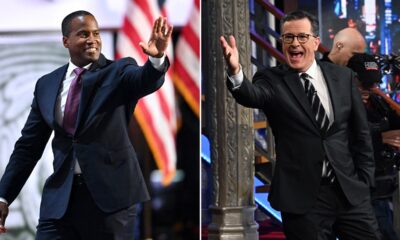
 Midwest1 week ago
Midwest1 week agoMichigan rep posts video response to Stephen Colbert's joke about his RNC speech: 'Touché'
-

 News1 week ago
News1 week agoVideo: Young Republicans on Why Their Party Isn’t Reaching Gen Z (And What They Can Do About It)
-

 Movie Reviews1 week ago
Movie Reviews1 week agoMovie Review: A new generation drives into the storm in rousing ‘Twisters’
-

 News1 week ago
News1 week agoIn Milwaukee, Black Voters Struggle to Find a Home With Either Party
-

 Politics1 week ago
Politics1 week agoFox News Politics: The Call is Coming from Inside the House
-

 News1 week ago
News1 week agoVideo: J.D. Vance Accepts Vice-Presidential Nomination
-

 World1 week ago
World1 week agoTrump to take RNC stage for first speech since assassination attempt



